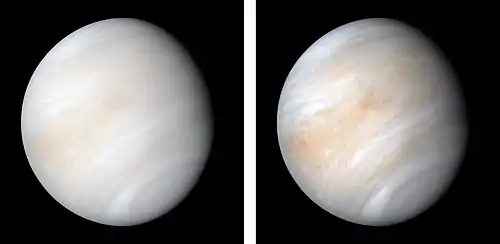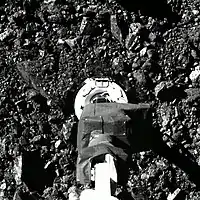2020 PN1
2020 PN1 is a sub-kilometer asteroid, classified as a near-Earth object of the Aten group, that is a temporary horseshoe companion to the Earth. There are dozens of known Earth horseshoe librators, some of which switch periodically between the quasi-satellite and the horseshoe co-orbital states.[6]
| Discovery | |
|---|---|
| Discovered by | ATLAS-HKO |
| Discovery site | Haleakalā Observatory |
| Discovery date | 12 August 2020 |
| Designations | |
Designation | 2020 PN1 |
| Orbital characteristics[2][3][4] | |
| Epoch 31 May 2020 (JD 2459000.5) | |
| Uncertainty parameter 0 | |
| Observation arc | 361 days |
| Aphelion | 1.12482093 AU |
| Perihelion | 0.8713906 AU |
| 0.998105754 AU | |
| Eccentricity | 0.1269557 |
| 1.00 y (364.219560 d) | |
| 32.06964° | |
| Inclination | 4.80807° |
| 145.63610° | |
| 55.40365° | |
| Earth MOID | 0.0248258 AU |
| Physical characteristics | |
| Dimensions | 10–50 m[a][5] |
| 25.5[2] | |
Discovery
2020 PN1 was discovered on 12 August 2020 by L. Denneau, J. Tonry, A. Heinze, and H. Weiland observing for the ATLAS-HKO Survey.[7] As of 20 January 2021, it has been observed 41 times with an observation arc of 361 days.[2]
Orbit and orbital evolution
2020 PN1 is currently an Aten asteroid (Earth-crossing but with a period less than a year). Its semi-major axis (currently 0.998105754 AU) is similar to that of Earth (0.999789 AU), but it has a moderate eccentricity (0.1269557) and low orbital inclination (4.80807°). It alternates between being an Aten asteroid and being an Apollo asteroid, although its orbital evolution is not fully stable and it can be considered as a temporary co-orbital companion to the Earth.[6]
Physical properties
With an absolute magnitude of 25.5 mag, it has a diameter in the range 10–50 meters (for an assumed albedo range of 0.04–0.20, respectively).
Notes
- ^ This is assuming an albedo of 0.20–0.04.
References
- List Of Aten Minor Planets
- 2020 PN1 at the JPL Small-Body Database
- Close approach · Discovery · Ephemeris · Orbit diagram · Orbital elements · Physical parameters Retrieved 2021-01-20
- AstDys-2 on 2020 PN1 Retrieved 2021-01-20
- NEODyS-2 on 2020 PN1 Retrieved 2021-01-20
- Absolute-magnitude conversion table (H)
- de la Fuente Marcos, Carlos; de la Fuente Marcos, Raúl (March 2021). "Using Mars co-orbitals to estimate the importance of rotation-induced YORP break-up events in Earth co-orbital space". Monthly Notices of the Royal Astronomical Society. 501 (4): 6007–6025. arXiv:2101.02563. Bibcode:2021MNRAS.501.6007D. doi:10.1093/mnras/stab062.
- Discovery MPEC
- Further reading
- Understanding the Distribution of Near-Earth Asteroids Bottke, W. F., Jedicke, R., Morbidelli, A., Petit, J.-M., Gladman, B. 2000, Science, Vol. 288, Issue 5474, pp. 2190–2194.
- A Numerical Survey of Transient Co-orbitals of the Terrestrial Planets Christou, A. A. 2000, Icarus, Vol. 144, Issue 1, pp. 1–20.
- Debiased Orbital and Absolute Magnitude Distribution of the Near-Earth Objects Bottke, W. F., Morbidelli, A., Jedicke, R., Petit, J.-M., Levison, H. F., Michel, P., Metcalfe, T. S. 2002, Icarus, Vol. 156, Issue 2, pp. 399–433.
- Transient co-orbital asteroids Brasser, R., Innanen, K. A., Connors, M., Veillet, C., Wiegert, P., Mikkola, S., Chodas, P. W. 2004, Icarus, Vol. 171, Issue 1, pp. 102–109.
- A trio of horseshoes: past, present and future dynamical evolution of Earth co-orbital asteroids 2015 XX169, 2015 YA and 2015 YQ1 de la Fuente Marcos, C., de la Fuente Marcos, R. 2016, Astrophysics and Space Science, Vol. 361, Issue 4, article 121 (13 pp).
External links
- Discovery MPEC
- 2020 PN1 data at MPC
- 2020 PN1 at NeoDyS-2, Near Earth Objects—Dynamic Site
- Ephemeris · Obs prediction · Orbital info · MOID · Proper elements · Obs info · Close · Physical info · NEOCC
- 2020 PN1 at ESA–space situational awareness
- 2020 PN1 at the JPL Small-Body Database


_on_Jul_14_2020_aligned_to_stars.jpg.webp)